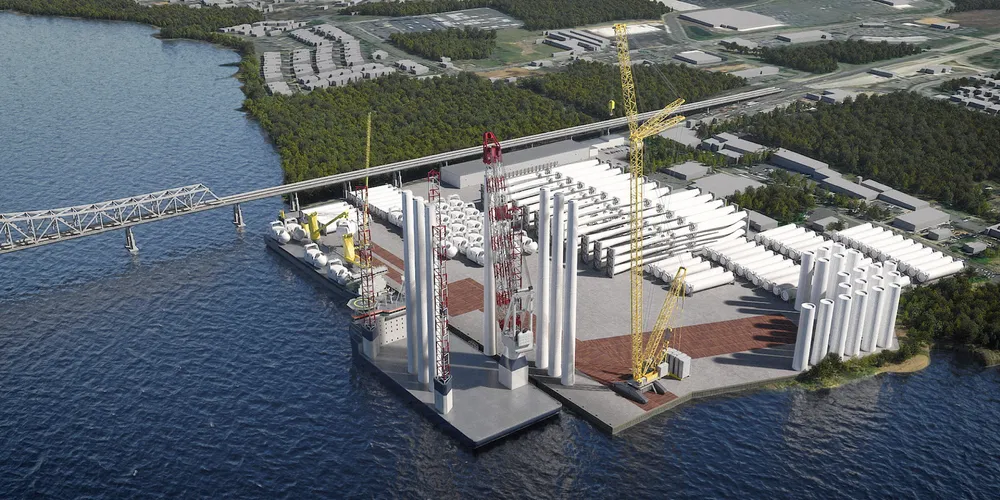Port space shortfall looms 'from 2023' as US marshals for giga-scale offshore wind build: study
State-led regional collaboration key to having necessary construction and service infrastructure in place to support Biden administration's 30GW 'national goal' for sector, finds University of Delaware research

The emerging US offshore wind sector faces a looming “port area shortfall” from 2023 as it sets about building a planned first wave of utility-scale projects off the country’s eastern seaboard, adding to a growing list of industrial headaches including grid pinchpoints and manufacturing and vessel constraints, a new study from the University of Delaware has concluded.
Most of these ports are too small in scale to handle the industrial requirements of the burgeoning wind power sector, noted the University of Delaware researchers, and the total shortfall is only going to compound over time, with postponed earlier projects knocking-on to hinder the aimed-for giga-scale rollout and the US’ wider efforts at decarbonisation of its power supply.
“Following 2022, however, there is an immediate port area shortfall. From 2023 to 2035, state procurement demand far exceeds our measured marshalling port supply,” the study notes.
As New Bedford will be unable to cope with the entire project itself, two additional ports will be drafted into service, adding layers of complexity to what is already a logistically challenging project.
This ‘feeder barge’ system has already been deployed for the two projects already in the water – the 30MW Block Island array off Rhode Island and the 12MW CVOW pilot off Virginia – but also adds cost, complexity and time to project installation. Estimates are that if a WTIV can come into port to retrieve components directly, total installation time for each turbine is around 32 hours, while the feeder barge system requires about 50 hours.
But even this will not be enough to meet demand estimated at 5GW annually through the 2030 deadline, and such workarounds will not only contribute to a slower installation process but will impede innovation, with newer methods for installation also requiring larger port capacity.
“Opportunities for improved methods exist with more assembly in port and simpler installation vessels, made possible by large ports and turbine support structures designed for in-port assembly and upright transport,” the report states, which will be impossible with the ports currently under development.
The scarcity of large-scale port facilities in the US northeast is often attributed to the dense populations centres in these states and the high costs of coastal real estate that is often either already developed, protected via environmental sanctuaries, or is otherwise unfit for industrial development.
But the University of Delaware researchers say that issue stems more from “developers having built ports to support early, smaller projects, and having located them to incentivise state power contracts rather than developing ports for long-term, large-scale, and economically-efficient use”.
While most offshore wind ports are being constructed by project developers as part of their procurement bids, “an offshore wind developer arguably is a suboptimal party to develop a marshalling port [due to] shorter time perspective and different investment priorities... leading to building of smaller ports, and ports only adapted to today’s deployment methods and turbine sizes”.
The study recommends a state-led regional approach to port development that could maximise economies of scale, citing New Jersey, which has a 260-acre wind port under development in Salem County, as “a great example of the foresight needed to make the necessary moves” to ensure adequate supply of port capacity, Parkison said.
The two-stage New Jersey Wind Port (NJWP), set for completion in 2026, is being built on reclaimed land owned by local utility PSEG, adjacent to the operating Salem and Hope Creek nuclear power generating stations, to support construction of the 1.1GW Ocean Wind 1 project it is developing with Orsted.
A combination of heavy engineering and sizeable investment – along with a slew of permitting and approval documents – will be needed to make the site suitable for use as an offshore wind port. The New Jersey Economic Development Authority spearheaded the investment, and has already accepted multiple bids not only for marshalling but manufacturing and assembly facilities within the NJWP site.
“[The NJWP] is a perfect example of land being out there [for wind port construction] but which requires a heavy amount of investment [and] the vision to have those conversations, to get the permitting underway, and to think about your port from a regional standpoint of servicing a broader market beyond the projects that are just specific to your state,” said Parkison.